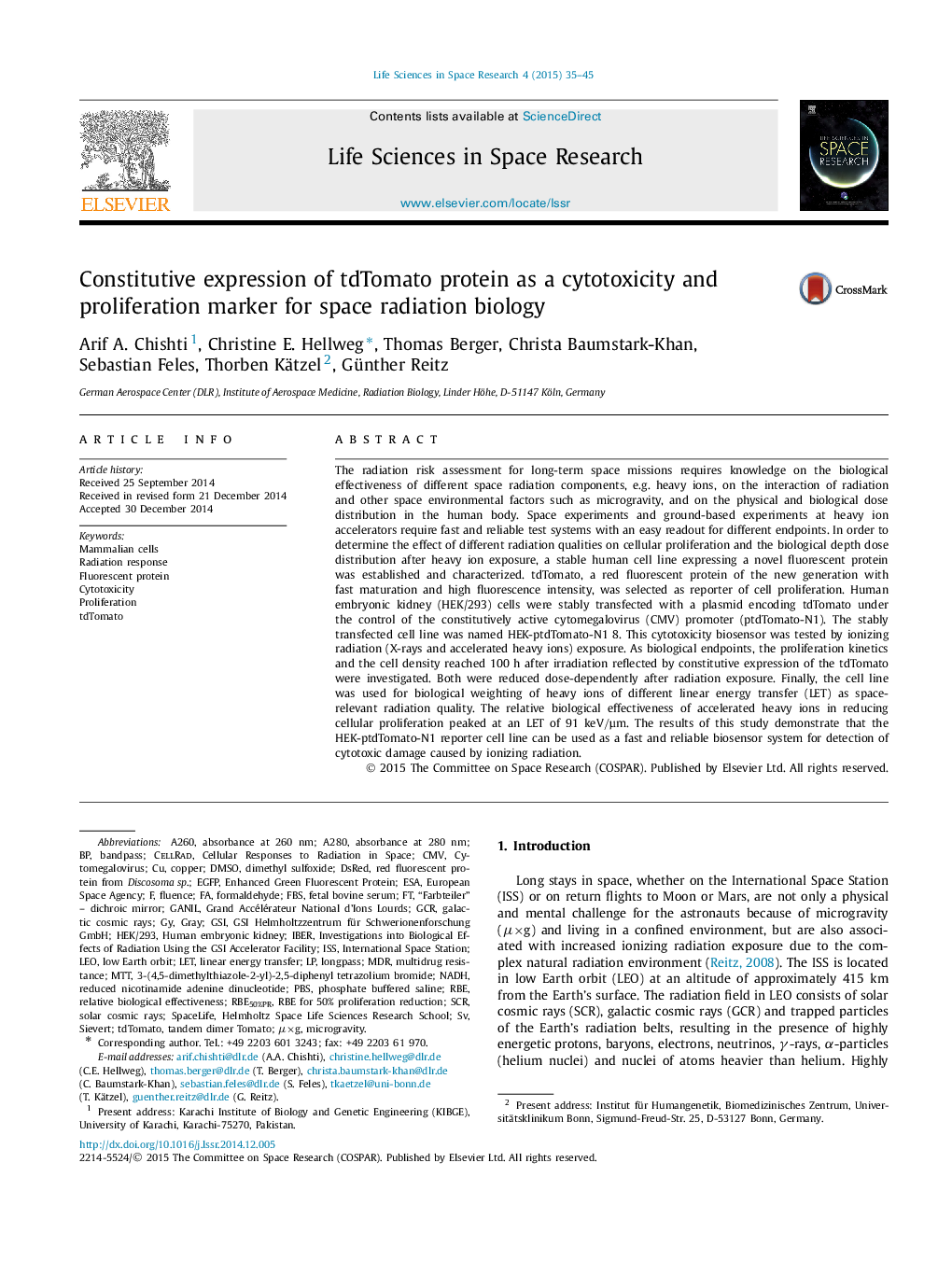| کد مقاله | کد نشریه | سال انتشار | مقاله انگلیسی | نسخه تمام متن |
|---|---|---|---|---|
| 8248107 | 1533320 | 2015 | 11 صفحه PDF | دانلود رایگان |
عنوان انگلیسی مقاله ISI
Constitutive expression of tdTomato protein as a cytotoxicity and proliferation marker for space radiation biology
دانلود مقاله + سفارش ترجمه
دانلود مقاله ISI انگلیسی
رایگان برای ایرانیان
کلمات کلیدی
A260tdTomatoeGFPLEORBE3-(4,5-dimethylthiazole-2-yl)-2,5-diphenyl tetrazolium bromideGCRDsRedESAFBSISSsievertMDRPBSGSIA280DMSO - DMSOMTT - MTTEuropean Space Agency - آژانس فضایی اروپاRelative biological effectiveness - اثربخشی بیولوژیکی نسبیLET - اجازه دهیدsolar cosmic rays - اشعه کیهانی خورشیدیGalactic cosmic rays - اشعه کیهانی کهکشانیLinear Energy Transfer - انتقال انرژی خطیInternational space station - ایستگاه فضایی بین المللیBandpass - باند پاسProliferation - ترویجabsorbance at 280 nm - جذب در 280 نانومترGray - خاکستریDimethyl sulfoxide - دیمتیل سولفواکسیدMicrogravity - ریزگرانش یا میکروگرانشfetal bovine serum - سرم جنین گاوMammalian cells - سلول های پستاندارانCytotoxicity - سمیت سلولیcytomegalovirus - سیتومگالوویروسCMV - سیتومگالوویروسFormaldehyde - فرمالدئیدPhosphate buffered saline - فسفات بافر شورFluence - فلوئنسLow earth orbit - مدار زمین کمCopper - مسMultidrug resistance - مقاومت چند داروییNADH - نادانradiation response - پاسخ تشعشعFluorescent protein - پروتئین فلورسنتenhanced green fluorescent protein - پروتئین فلورسنت سبز افزایش یافته استreduced nicotinamide adenine dinucleotide - کاهش ninocotinamide adenine dinucleotidehuman embryonic kidney - کلیه جنین انسانSCR - یکسوساز کنترلشده با سیلیکون
موضوعات مرتبط
مهندسی و علوم پایه
علوم زمین و سیارات
علوم فضا و نجوم
پیش نمایش صفحه اول مقاله

چکیده انگلیسی
The radiation risk assessment for long-term space missions requires knowledge on the biological effectiveness of different space radiation components, e.g. heavy ions, on the interaction of radiation and other space environmental factors such as microgravity, and on the physical and biological dose distribution in the human body. Space experiments and ground-based experiments at heavy ion accelerators require fast and reliable test systems with an easy readout for different endpoints. In order to determine the effect of different radiation qualities on cellular proliferation and the biological depth dose distribution after heavy ion exposure, a stable human cell line expressing a novel fluorescent protein was established and characterized. tdTomato, a red fluorescent protein of the new generation with fast maturation and high fluorescence intensity, was selected as reporter of cell proliferation. Human embryonic kidney (HEK/293) cells were stably transfected with a plasmid encoding tdTomato under the control of the constitutively active cytomegalovirus (CMV) promoter (ptdTomato-N1). The stably transfected cell line was named HEK-ptdTomato-N1 8. This cytotoxicity biosensor was tested by ionizing radiation (X-rays and accelerated heavy ions) exposure. As biological endpoints, the proliferation kinetics and the cell density reached 100 h after irradiation reflected by constitutive expression of the tdTomato were investigated. Both were reduced dose-dependently after radiation exposure. Finally, the cell line was used for biological weighting of heavy ions of different linear energy transfer (LET) as space-relevant radiation quality. The relative biological effectiveness of accelerated heavy ions in reducing cellular proliferation peaked at an LET of 91 keV/μm. The results of this study demonstrate that the HEK-ptdTomato-N1 reporter cell line can be used as a fast and reliable biosensor system for detection of cytotoxic damage caused by ionizing radiation.
ناشر
Database: Elsevier - ScienceDirect (ساینس دایرکت)
Journal: Life Sciences in Space Research - Volume 4, January 2015, Pages 35-45
Journal: Life Sciences in Space Research - Volume 4, January 2015, Pages 35-45
نویسندگان
Arif A. Chishti, Christine E. Hellweg, Thomas Berger, Christa Baumstark-Khan, Sebastian Feles, Thorben Kätzel, Günther Reitz,